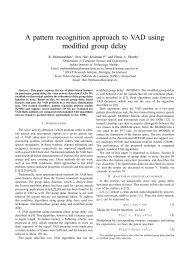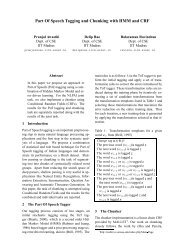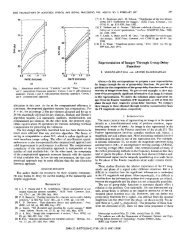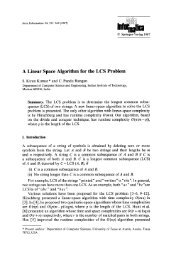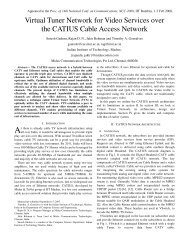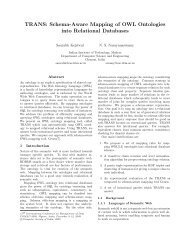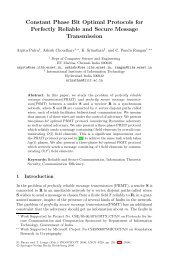On Byzantine Agreement over (2,3)-Uniform ... - Cornell University
On Byzantine Agreement over (2,3)-Uniform ... - Cornell University
On Byzantine Agreement over (2,3)-Uniform ... - Cornell University
You also want an ePaper? Increase the reach of your titles
YUMPU automatically turns print PDFs into web optimized ePapers that Google loves.
<strong>On</strong> <strong>Byzantine</strong> <strong>Agreement</strong> <strong>over</strong> (2, 3)-<strong>Uniform</strong> Hypergraphs 455<br />
Fig. 1. Views: {p 1,p 2,p 3},{p ′ 1,p ′ 2,p ′ 3} & {p ′ 1,p 4,p 3}.<br />
Observation 1 <strong>Byzantine</strong> agreement is not achievable on four node hypergraph<br />
H tolerating the adversary A characterized by the adversary structure A adv =<br />
{{p 2 }, {p 4 }} if {p 2 ,p 4 } disconnects the hypergraph.<br />
We shall now continue with the proof of the necessity of conditions 1 and 2<br />
of Theorem 1. Specifically we prove that <strong>Byzantine</strong> agreement is not achievable<br />
among n processes tolerating t faults if the hypergraph is not (2,n)-hyper-(2t +<br />
1)-connected.<br />
<strong>On</strong> the contrary, assume a protocol Π exists for <strong>Byzantine</strong> agreement on<br />
some hypergraph H(P, E) thatisnot(2,n)-hyper-(2t + 1)-connected. The main<br />
idea of the proof is to construct a protocol Π ′ that achieves <strong>Byzantine</strong> agreement<br />
on a four node hypergraph H ′ tolerating the adversary A characterized<br />
by the adversary structure A adv = {{p 2 }, {p 4 }} where {p 2 ,p 4 } disconnects the<br />
hypergraph H ′ . This leads to a contradiction since existence of such Π ′ violates<br />
Observation 1.<br />
Let n>(2t + 1), assume that H(P, E) isnot(2,n)-hyper-(2t + 1)-connected.<br />
That is there exist a set of 2t processes that disconnect H. Partition this set<br />
into two sets of t processes each, say P 2 and P 4 . <strong>On</strong> removal of the 2t processes,<br />
the hypergraph disconnects into at least two components, let the processes in<br />
one component be P 1 and the processes in the remaining components be P 3 .<br />
Processes in P 1 and P 3 are disconnected from each other. Thus there does not<br />
exist a hyperedge in E which has non empty intersection with both P 1 and P 3 .<br />
Construct a hypergraph H ′ (P ′ ,E ′ ) on four processes where P ′ = {p 1 ,p 2 ,p 3 ,<br />
p 4 }, {p i ,p j }∈E ′ if P i and P j are connected in H (there is a hyperedge e ∈ E<br />
that has non empty intersection with each of P i ,P j )and{p i ,p j ,p k }∈E ′ if<br />
P i ,P j and P k are connected in H (there is a hyperedge e ∈ E that has non<br />
empty intersection with each of P i ,P j ,P k ). It follows from the earlier argument<br />
that {p 1 ,p 3 } ∉ E ′ and hence {p 2 ,p 4 } disconnects H ′ .<br />
Using the protocol Π, construct a protocol Π ′ for <strong>Byzantine</strong> agreement<br />
among the processes in P ′ connected by the hypergraph H ′ by allowing p i simulate<br />
the behavior of processes in P i for i =1, 2, 3, 4. Processes p i simulate the<br />
behavior of processes in P i as follows: (a) Set the inputs of all players in P i as<br />
the input of p i , (b) In each round, messages sent among p ∈ P i and q ∈ P j using<br />
the hyperedge {p, q} ∈E are sent using the hyperedge {i, j} ∈E ′ ({i, j} ∈E ′



